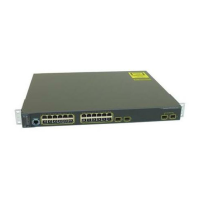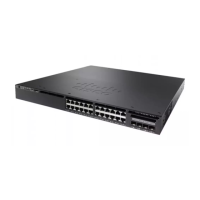2
The RP puts a link to Router C in its outgoing interface list.
3
A source sends data; Router A encapsulates the data in a register message and sends it to the RP.
4
The RP forwards the data down the shared tree to Router C and sends a join message toward the source.
At this point, data might arrive twice at Router C, once encapsulated and once natively.
5
When data arrives natively (unencapsulated) at the RP, it sends a register-stop message to Router A.
6
By default, reception of the first data packet prompts Router C to send a join message toward the source.
7
When Router C receives data on (S, G), it sends a prune message for the source up the shared tree.
8
The RP deletes the link to Router C from the outgoing interface of (S, G). The RP triggers a prune message
toward the source.
Join and prune messages are sent for sources and RPs. They are sent hop-by-hop and are processed by each
PIM device along the path to the source or RP. Register and register-stop messages are not sent hop-by-hop.
They are sent by the designated router that is directly connected to a source and are received by the RP for
the group.
Multiple sources sending to groups use the shared tree. You can configure the PIM device to stay on the shared
tree.
The change from shared to source tree happens when the first data packet arrives at the last-hop router. This
change depends upon the threshold that is configured by using the ip pim spt-threshold global configuration
command.
The shortest-path tree requires more memory than the shared tree but reduces delay. You may want to postpone
its use. Instead of allowing the leaf router to immediately move to the shortest-path tree, you can specify that
the traffic must first reach a threshold.
You can configure when a PIM leaf router should join the shortest-path tree for a specified group. If a source
sends at a rate greater than or equal to the specified kbps rate, the multilayer switch triggers a PIM join message
toward the source to construct a source tree (shortest-path tree). If the traffic rate from the source drops below
the threshold value, the leaf router switches back to the shared tree and sends a prune message toward the
source.
You can specify to which groups the shortest-path tree threshold applies by using a group list (a standard
access list). If a value of 0 is specified or if the group list is not used, the threshold applies to all groups.
Related Topics
Delaying the Use of PIM Shortest-Path Tree (CLI), on page 167
Reverse Path Forwarding
In unicast routing, traffic is routed through the network along a single path from the source to the destination
host. A unicast router does not consider the source address; it considers only the destination address and how
to forward the traffic toward that destination. The router scans through its routing table for the destination
network and then forwards a single copy of the unicast packet out the correct interface in the direction of the
destination.
In multicast forwarding, the source is sending traffic to an arbitrary group of hosts that are represented by a
multicast group address. The multicast router must determine which direction is the upstream direction (toward
the source) and which one is the downstream direction (or directions) toward the receivers. If there are multiple
downstream paths, the router replicates the packet and forwards it down the appropriate downstream paths
(best unicast route metric)--which is not necessarily all paths. Forwarding multicast traffic away from the
IP Multicast Routing Configuration Guide, Cisco IOS XE Release 3.6E (Catalyst 3850 Switches)
138 OL-32598-01
Configuring PIM
Multicast Forwarding

